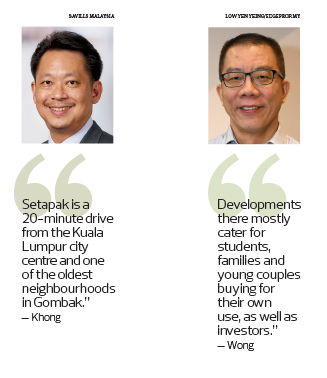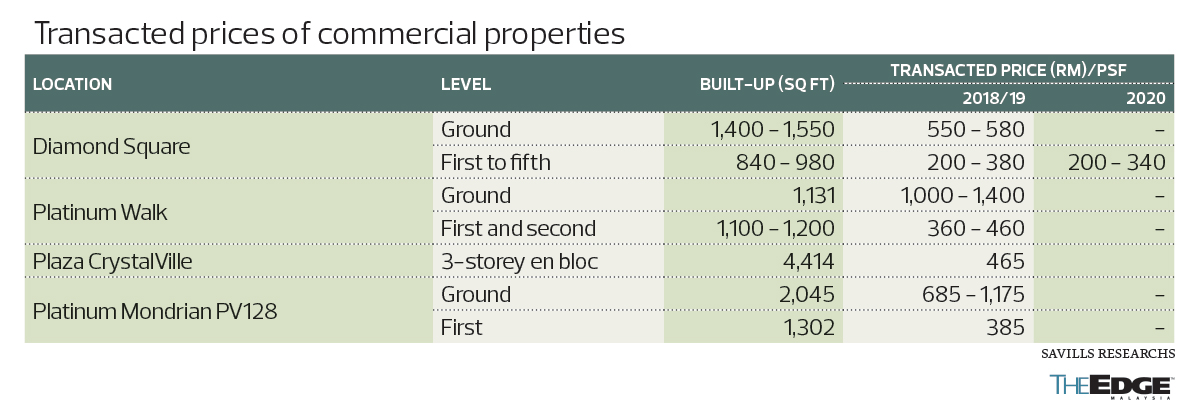
Upcoming MRT Line 3 to enhance connectivity in Setapak (Photo by Sam Fong/The Edge)
This article first appeared in City & Country, The Edge Malaysia Weekly on October 25, 2021 - October 31, 2021
Known as one of Kuala Lumpur’s most sought-after urban precincts, Setapak is a densely populated and busy neighbourhood with both old and new commercial and residential developments.
The area has seen its student population increase steadily over the years, thanks to educational institutions and schools such as Tunku Abdul Rahman University College, VTAR Institute, Institute of Childhood Education-Studies & Community Education, SMK Danau Kota, SK Setapak and Sri Utama International School.
Other amenities nearby include Setapak Central Mall, The Palette, Giant Hypermarket Setapak, Columbia Asia Hospital, KPJ Tawakkal KL Specialist Hospital, Kuala Lumpur General Hospital and Royal Selangor Visitor Centre.
According to Savills Malaysia Sdn Bhd managing director Datuk Paul Khong, Setapak was once a tin mining and rubber plantation area that was inhabited by the Orang Asli and the Minangkabau people from West Sumatra.
On April 12, 1884, Selangor’s British resident Frank Swettenham appealed for the reappointment of Batu Tapak as headman of the Orang Asli community in the area, and Setapak was named after him.
“The name ‘Setapak’ means ‘one step’ in Malay. It is a 20-minute drive from the Kuala Lumpur city centre and is one of the oldest neighbourhoods in Gombak,” says Khong.
In terms of connectivity, Setapak enjoys good accessibility with links to major roads, such as Jalan Genting Kelang, Jalan Gombak and Jalan Tun Razak, and highways such as the Middle Ring Road 2, Duta-Ulu Kelang Expressway (DUKE) and the upcoming Setiawangsa-Pantai Expressway (DUKE 3). Transport hubs in the vicinity include the Wangsa Maju, Sri Rampai and Setiawangsa LRT stations.
The upcoming MRT Line 3, which has a proposed station in Air Panas, is expected to further enhance connectivity in the area. Slated for completion by 2024, the MRT line will form part of the Greater KL/Klang Valley Integrated Transit System and is expected to cover the hotspots in Bandar Malaysia, KL Eco City, Bukit Kiara and Sentul.
Setapak’s rapid urbanisation has led to growing demand for residential properties in the area. Responding to the call for more integrated developments in the thriving suburb, numerous developers have launched residential and commercial projects there, including high-rises and retail centres/hubs.
Khong says Platinum Victory Holdings Sdn Bhd and SkyWorld Development Sdn Bhd are among the prominent developers that have helped make Setapak a well-developed, high-density neighbourhood. Platinum Victory has established itself as one of the pioneer developers with strata developments and delivered more than 3,000 units and retail spaces in the area.
“As for SkyWorld, the 28-acre SkyArena was the developer’s first master development there. Phase 1, Ascenda Residences, which was launched in 2014, was fully taken up and the units were handed over in 2017. Phase 2, Bennington Residences, is 95% sold since its launch in 2016 and the handover started in 2019,” he adds.
Nawawi Tie Leung Sdn Bhd managing director Eddy Wong points out that Setapak has gained prominence over the past 10 years with the many high-rise developments coming up on both sides of Jalan Genting Kelang, which have dramatically transformed the area. Demand is good as the location is near the city centre, but the prices are still comparatively affordable.
Upcoming residential projects include Platinum Victory’s PV18 Residence @ Setapak Lake City (to be completed in 4Q2021), Vista Langkawi @ PV18 Block C (4Q2021), PV9 Residence (2022) and Vista Danau Kota Residensi Wilayah (2024 or 2025); Platinum Victory and MH Group’s MH Platinum 2 Residences (2Q2025); Platinum Victory and Jakel Group’s J.Satine (3Q2024); Kenwingston Venture Sdn Bhd’s Kenwingston Platz (4Q2023); SkyWorld’s Curvo Residences @ SkyArena (2025) and EdgeWood Residences @ SkySanctuary (2025); and Mah Sing Group Bhd’s M Astra (2025). Platinum Victory’s Platinum Casa Danau is still in the planning stage.
Notable completed residential and commercial projects in the area include KP Property Sdn Bhd’s 288 Residency and 222 Residency (completed in 2013); UOA Development Bhd’s Setapak Green (2013); Platinum Victory’s PV18 Residences (2021) and Platinum Teratai (2019); Crystal Ville Group’s Plaza CrystalVille (2010); SkyWorld’s Ascenda Residences (2017), Bennington Residences @ SkyArena (2019) and SkyAwani 3 Residences (2021); and Sierra Cube Sdn Bhd’s The Nest @ Genting Kelang (2018).
Khong says Setapak remains a relatively affordable neighbourhood for the mass market. The average price of properties on the secondary market for a 3-bedroom residential unit with built-ups of 1,000 to 1,300 sq ft is less than RM500,000.
Both Khong and Wong note that there is a good balance of owner-occupiers and tenants in the area. “Developments there mostly cater for students, families and young couples buying for their own use, as well as investors who buy to rent out the property to students from the surrounding educational institutions,” says Wong.
Stable demand
According to Khong, residential properties in Setapak generally see stable demand as there is a population of 293,280 (as at 2010) residing in this area. The largest segment of landed properties is terraced houses, which make up about 88% of the total landed transactions, followed by semi-detached and detached houses at 4% and 8% respectively.
“Owing to the scarcity of land, there have been no new offerings of such products in the vicinity,” he says, adding that such properties are usually sold on the secondary market, with a limited number of transactions.
Wong says there were some 1-storey semidees in the older parts of Taman Air Panas that transacted for RM350,000. The price reflects their age and tenure of about 33 years remaining on their lease.
Owing to Kuala Lumpur City Hall’s (DBKL) guidelines on the renovation of landed properties, which allows existing 1-storey terraced houses to be rebuilt/redeveloped into 2- or 3-storey houses, more buyers are now keen to purchase an old terraced house in Setapak for redevelopment and to increase the gross floor area.
Transaction data provided by Savills Research show that 1-, 2- and 3-storey terraced houses in Setapak Garden with built-ups of 800 to 2,575 sq ft were transacted at RM460,000 to RM1.2 million from 2018 to 2020. One-storey terraced houses with a built-up of 800 sq ft in Setapak Indah were sold for RM400,000 to RM580,000 in 2018 and 2019, and one unit at RM540,000 in 2020, while two-storey terraced houses with built-ups of 1,500 to 2,000 sq ft were transacted at RM570,000 to RM650,000 in 2018 and 2019. Monthly rents ranged from RM1,300 to RM2,800, offering a yield of 2.5% to 3.3% per annum.
One-storey semidees (2,000 sq ft) in Setapak Green were sold for RM800,000 to RM870,000 in 2018 and 2019, and one unit at RM700,000 in 2020, while 2-storey detached houses with a built-up of 2,600 sq ft went for RM1.46 million to RM1.55 million in 2018 and 2019.
One-storey detached houses with a built-up of 1,700 sq ft in Taman P Ramlee were transacted at RM1.2 million to RM1.6 million in 2018 and 2019, and one unit at RM1.3 million in 2020. Rents are RM2,000 to RM3,000 a month, which translate into a yield of 2% to 2.3% a year.
As for the high-rises, Khong says about 47.3% of the overall transactions on the secondary market are apartments, with built-ups of 800 to 1,199 sq ft being the most popular segment. This is followed by larger units with built-ups of 1,200 to 1,599 sq ft, at 34.2%.
Wong says the prices of high-rises in the area have been relatively stable, depending on the type of development. Some transactions have increased in price while others have experienced a slight softening, but all within a narrow band. The asking prices of high-rises usually range from RM350 to RM550 psf.
As for the incoming supply from ongoing projects in the area, the take-up rate is still relatively strong despite the Covid-19 pandemic, says Khong, as this market segment is being shored up by low interest rates and the Home Ownership Campaign that was extended until Dec 31 this year.
“The 2-bedroom units, with an average built-up of 908 sq ft, were sold for RM464 psf in 2020, while the 3, 3+1 and 4-bedroom units, with an average built-up of 1,053 to 1,293 sq ft, were transacted at RM339 to RM379 psf from 2018 to 2020. Asking rents are currently RM1.18 to RM1.38 psf per month, giving a yield of 3.5% to 4.3% a year,” he adds.
In the commercial sector, Savills Research data shows that the ground floor shops in Diamond Square with built-ups of 1,400 to 1,550 sq ft were sold for RM550 to RM580 psf in 2018 and 2019, while the upper floors with built-ups of 840 to 980 sq ft were transacted at between RM200 and RM380 psf from 2018 to 2020.
In 2018 and 2019, the ground floor shops in Platinum Walk, with a built-up of 1,131 sq ft, were transacted at RM1,000 to RM1,400 psf, whereas those on the first and second floors, with built-ups of 1,100 to 1,200 sq ft, were transacted between RM360 and RM460 psf in 2018 and 2019.
“The 3-storey en bloc shopoffices in Plaza CrystalVille have a built-up of 4,414 sq ft and were transacted at RM465 psf in 2018 and 2019. As for the shops in Platinum Mondrian PV128, the 2,045 sq ft ground floor units were transacted at RM685 to RM1,175 psf in 2018 and 2019, while the first floor units, with a built-up of 1,302 sq ft, were sold for RM385 psf during the period,” says Khong.
“The ground floor units command rents of RM2 to RM4.50 psf. The higher the unit, the lower the rent, with the upper floors fetching only RM1 to RM1.30 psf per month, which translates into a yield of 2.7% to 5% a year.”
Looking ahead
Wong says the outlook for Setapak appears positive due to its proximity to the city centre, its relatively affordable property prices and the improvement of infrastructure.
Khong agrees, stating that the area will benefit from the upcoming MRT Line 3, which will enhance rail connectivity from Setapak, linking to key growth areas such as the Tun Razak Exchange, Mid Valley City and KL Sentral. “Properties in the area are expected to remain relatively resilient due to the strong middle-class demand and big catchment area, good existing and new infrastructure facilities, as well as the continuation of job opportunities in the city centre.”
Save by subscribing to us for your print and/or digital copy.
P/S: The Edge is also available on Apple's App Store and Android's Google Play.
- Amir Hamzah: Targeted EPF withdrawals no longer relevant after introduction of Flexible Account
- Malaysian officials advise Anwar to soften Israel-Hamas rhetoric for Trump — Bloomberg
- Special Report: Malaysia Airlines back in the red as supply chain woes cloud its skies
- No settlement, so hearing of appeals by Semantan Estate and govt to proceed tomorrow
- Nationgate: Balancing Nvidia boom with market jitters
- Trump backs US$4.5 tril tax cut in House GOP budget plan
- Singapore Court of Appeal grants stay of execution to Pannir Selvam
- Finance bosses press UK's Reeves to ease investment taxes, Reuters reports
- Wall St slips after Trump's latest tariffs threat
- Nigeria suing Binance for US$81.5b in economic losses and back tax





